Are you trying to make your restaurant or catering business more sustainable? The search for reliable, high-quality wholesale bamboo tableware can be frustrating. You face a sea of options with unclear quality and questionable eco-claims, making it hard to choose confidently. This guide is here to help you source the perfect bamboo products for your business.
To successfully source wholesale bamboo tableware, you must focus on three key areas: product quality, supplier certifications, and manufacturing transparency. Scrutinize the product’s finish for smoothness and durability. Verify critical certifications like FSC for sustainability and FDA/LFGB for food safety. Also, ask your supplier about their production methods to ensure no harmful chemicals are used. Partnering with an experienced exporter will streamline this process and guarantee you receive safe, genuinely sustainable products.
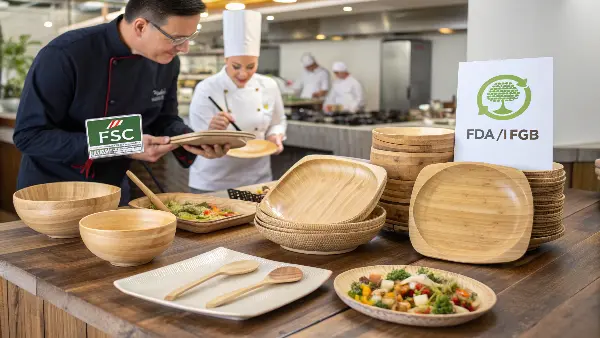
Finding the right tableware goes beyond simply picking a product from a catalog. It’s about making a choice that reflects your brand’s values, ensures your customers’ safety, and contributes positively to the environment. The details truly matter. In this guide, I’ll break down everything you need to know, from quality checks to international shipping, to help you make an informed decision. Let’s get started on building a better, greener supply chain for your business.
What Key Quality Factors Define Top-Tier Bamboo Tableware?
You found a supplier and placed a bulk order, only for the bamboo plates to arrive flimsy, splintered, or with a strange chemical smell. This is a nightmare scenario for any food business. Low-quality tableware not only disappoints customers but also poses a safety risk. By learning to spot key quality markers beforehand, you can avoid these costly mistakes.
To ensure top quality, always check the product’s finish, durability, and raw material composition. High-grade bamboo tableware feels smooth, has no splinters, and is consistent in shape and color. It should never have a strong chemical odor. Ask your supplier about their manufacturing process—especially whether the bamboo is heat-pressed or relies on adhesives. This knowledge helps you secure products that are safe, durable, and truly eco-friendly.
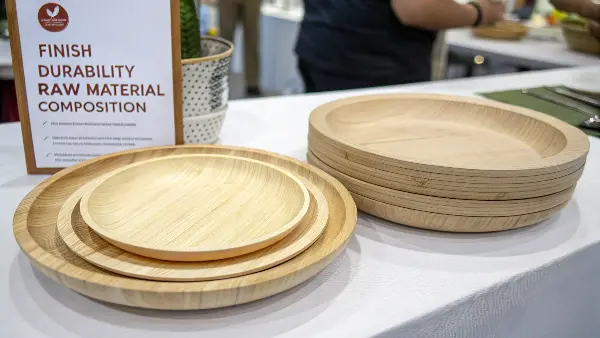
When I first started sourcing, I learned that not all bamboo products are created equal. The difference between a great product and a poor one often comes down to small details in how it’s made. To help you become an expert, let’s dive deeper into the specific quality indicators you should look for.
Distinguishing Between Product Types
First, you need to be clear about what you’re buying. Is it a disposable item for a single event, or a reusable plate for your restaurant? The quality standards are very different.
- Disposable Bamboo Tableware: This is typically made from the outer sheath of the bamboo plant. It’s thin, lightweight, and designed for one-time use. The key qualities here are sturdiness and resistance to moisture. It needs to hold up to hot, saucy, or greasy foods without breaking or becoming soggy. A good disposable plate feels strong, not flimsy.
- Reusable Bamboo Tableware: This is often made from a composite of bamboo fiber and a binder like food-grade melamine. It’s much thicker and more durable. When sourcing these, you should ask if they are dishwasher-safe, what their expected lifespan is, and what a safe temperature range is.
I always advise clients to request samples of both types to feel the difference firsthand.
Material Integrity and Safety
The source and treatment of the bamboo are critical. High-quality manufacturers use mature bamboo, which is stronger and more stable. The manufacturing process itself is another major factor.
| Manufacturing Method | Description | What to Look For |
|---|---|---|
| Heat-Pressed | Layers of bamboo are bonded using only high heat and pressure. | This is the premium choice. It results in a product with no added chemical binders. |
| Adhesive-Bonded | Bamboo fibers or strips are mixed with a binding agent (glue) and then molded. | You must verify that the supplier uses a food-grade, formaldehyde-free adhesive. |
You should always ask the supplier for documentation on their adhesives if they use them. A reputable partner will have this information ready.
Why Are Certifications Like FSC and FDA Crucial for Your Sourcing?
You want to tell your customers that your business is eco-friendly, but you lack the proof to back it up. Simply claiming to be "green" without verification is risky. Customers are more informed than ever and can easily spot greenwashing, which can seriously damage your brand’s credibility. The best way to protect your business is by demanding and verifying the right certifications.
Certifications provide undeniable proof of a product’s safety and sustainability. For example, FSC (Forest Stewardship Council) confirms the bamboo comes from a responsibly managed source. Food-contact certifications like FDA (for the U.S.) and LFGB (for the E.U.) ensure the items are safe for serving food. Others, like BSCI, signal ethical labor practices. These are essential for market access, brand protection, and earning customer trust.
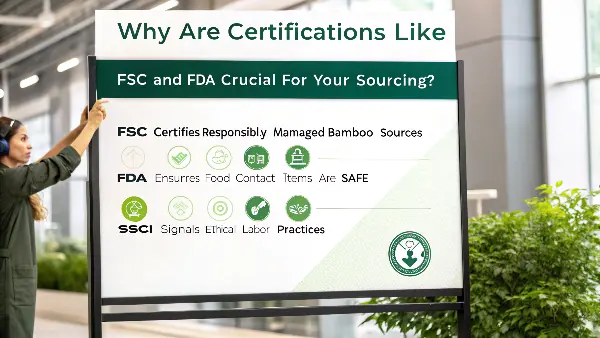
I once worked with a client, let’s call him Jacky from Canada, who was about to place a large order based on a supplier’s verbal promises. I insisted we first verify their certificates. It turned out their FSC certificate had expired a year ago. We dodged a bullet that could have led to a major branding crisis for Jacky. This is why I never skip the verification step. Let’s break down the most important certifications you’ll encounter.
Decoding Key Supply Chain Certifications
Navigating the world of certifications can feel complex, but focusing on a few key ones will cover most of your bases. Each one serves a different purpose, creating a chain of trust from the forest to your customer’s table.
| Certification | What It Guarantees | Why It Matters for Your Business |
|---|---|---|
| FSC (Forest Stewardship Council) | The bamboo was harvested responsibly, protecting biodiversity and a traceable supply chain. | This is your proof of environmental responsibility. It’s a powerful marketing tool for eco-conscious consumers. |
| FDA / LFGB | The product is safe for food contact and will not leach harmful chemicals. | This is non-negotiable for legal compliance in North America (FDA) and Europe (LFGB). It ensures customer safety. |
| BSCI (Business Social Compliance Initiative) | The factory adheres to fair labor practices, safe working conditions, and ethical business conduct. | This protects your brand from being associated with unethical production and shows you care about the entire supply chain. |
| ISO 9001 | The manufacturer has a certified Quality Management System in place. | This indicates that the supplier is committed to consistent product quality and continuous improvement. |
How to Verify a Supplier’s Claims
Never take a supplier’s word or a logo on their website at face value. A trustworthy partner will be transparent and proactive in sharing their documentation.
- Request the Certificate: Ask for a copy of the actual certificate document.
- Check the Details: Look at the company name, the certificate’s scope (does it cover the products you’re buying?), and the expiry date.
- Validate Online: Most certification bodies have public databases where you can look up the certificate number to confirm its authenticity. For FSC, you can use the FSC Certificate Database online.
This diligence is essential. It builds a foundation of trust with your supplier and gives you complete confidence in the products you sell.
What Customization Options Can You Expect for Wholesale Bamboo Tableware?
Using the same generic, unbranded tableware as everyone else does nothing to make your business stand out. In today’s competitive food and catering market, every customer touchpoint is a branding opportunity. Customizing your bamboo tableware is a simple yet powerful way to elevate your brand experience and leave a lasting impression.
Most suppliers offer customization for bamboo tableware that includes branding, unique shapes, and tailored packaging. You can typically add your logo through laser engraving or heat stamping on items like plates, cups, and cutlery. While custom shapes or sizes are possible, they often come with higher minimum order quantities (MOQs). Branded packaging, like custom sleeves for cutlery, further reinforces your brand identity.
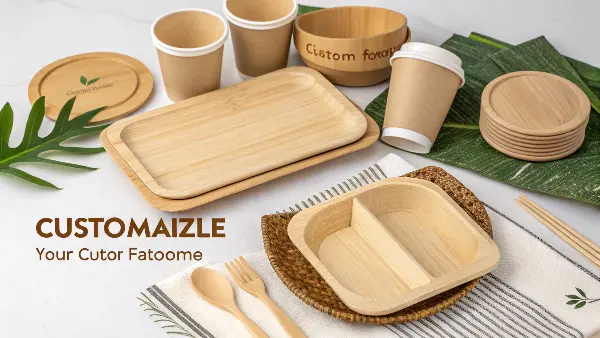
Branding your disposables transforms a simple utility item into a marketing tool. It shows attention to detail and reinforces your commitment to quality and sustainability. When customers see your logo on a beautiful bamboo plate, it connects your brand with a positive, eco-friendly experience. Let’s explore the most common ways you can make these products your own.
Common Customization Techniques
There are a few popular methods for adding your brand’s mark to bamboo products. Each has its own look and feel.
- Laser Engraving: This method uses a laser to etch your logo directly onto the bamboo surface. It creates a very clean, precise, and professional look. It’s perfect for detailed logos and doesn’t use any inks. This is often the preferred method for a sophisticated, modern aesthetic.
- Heat Stamping (Branding): In this process, a heated metal die of your logo is pressed onto the bamboo. It creates a slightly debossed, "branded" effect with a darker, sometimes rustic appearance. It’s very cost-effective, especially for simpler logos and large quantities.
- Custom Shapes and Molds: For businesses with unique needs and larger budgets, creating a custom mold is an option. You could design a plate with a special compartment or a bowl in a shape that reflects your brand. This requires a significant investment in tooling costs and much higher MOQs, so it’s best for established, high-volume businesses.
The Power of Custom Packaging
Don’t stop at the product itself. Custom packaging completes the branded experience.
- Cutlery Sleeves: Instead of loose cutlery, offer sets neatly wrapped in a paper sleeve printed with your logo and messaging.
- Retail Boxes: If you sell plate sets, design a branded box. This not only looks professional but also provides space to tell your brand’s sustainability story.
- Stickers and Labels: A simple, cost-effective solution is to add a custom-printed sticker to standard packaging.
When working with your supplier, be sure to provide your logo in a high-resolution vector format (like .AI or .EPS) for the best results. Always ask about lead times, as custom orders naturally take longer than standard ones.
How Do You Navigate the Logistics of Importing Bamboo Tableware?
You’ve finally found the perfect supplier in Asia and negotiated a great price. But now you’re faced with the daunting task of international shipping. The complex world of freight, customs, and hidden fees can be overwhelming. A misstep in logistics can quickly turn a profitable order into a financial headache with delays and unexpected costs. Understanding the key steps will give you control over the process.
Successfully navigating import logistics means clarifying shipment terms (Incoterms like FOB or DDP), accurately calculating your total landed cost, and preparing for customs. Your landed cost isn’t just the product price; it includes shipping, insurance, tariffs, and clearance fees. Your supplier or a freight forwarder is key here. Ensure all documents, like the Bill of Lading and Commercial Invoice, are accurate to avoid delays at the port.
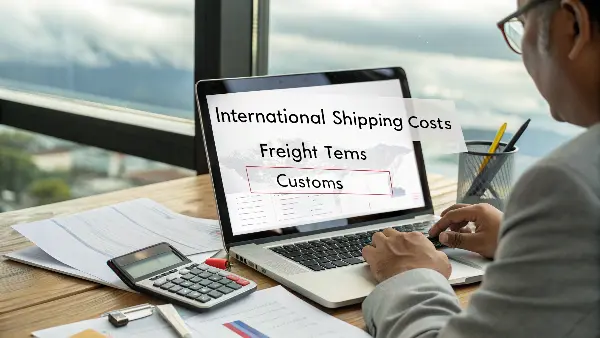
I find that many of our clients, especially those new to importing, feel the most anxiety around this step. They worry about their goods getting lost, damaged, or stuck in customs for weeks. That’s why working with an experienced export partner is so valuable. We handle these complexities every day. Let’s demystify the process so you can import with confidence.
Breaking Down Your Total Landed Cost
Your true cost is much more than the price per plate. The landed cost is the total amount it takes to get the product from the factory floor to your warehouse door. Here’s a simple breakdown:
| Cost Component | Description |
|---|---|
| Product Cost (e.g., FOB Price) | The price per unit you pay the factory. FOB (Free On Board) means the supplier is responsible until the goods are on the ship. |
| Ocean or Air Freight | The cost to transport the goods from the origin port to the destination port in your country. |
| Insurance | Essential for protecting your investment against loss or damage during transit. |
| Tariffs / Duties | Taxes that your country’s government imposes on imported goods. This varies greatly by product type and country. |
| Customs Broker Fees | The fee paid to a licensed professional who handles the customs clearance process on your behalf. |
| Local Delivery | The final cost to transport the goods from the port to your warehouse or business. |
Ask your supplier or a freight forwarder for a landed cost estimate before you finalize your order.
Essential Shipping Documents
Accurate paperwork is crucial for a smooth customs process. Three documents are fundamental:
- Commercial Invoice: Details the transaction, including the seller, buyer, product descriptions, quantities, and prices.
- Packing List: Specifies the contents of each box or pallet, including weights and dimensions. It’s used by customs to verify the shipment.
- Bill of Lading (B/L): The contract between you and the shipping company. It acts as a title to the goods.
Working with a supplier who understands the documentation requirements for your country is a huge advantage. They can help ensure everything is filled out correctly to prevent costly delays. At Ecosourcecn, we guide our partners through this every step of the way, making global sourcing feel as easy as buying locally.
Conclusion
Sourcing wholesale bamboo tableware is about much more than finding the lowest price. It’s a strategic decision that impacts your brand, customer safety, and environmental footprint. By focusing on quality, verifying certifications, exploring customization, and understanding logistics, you can build a reliable and responsible supply chain. This empowers your business to thrive while making a genuinely positive impact.


